[English] 日本語
 Yorodumi
Yorodumi- PDB-6yal: Mammalian 48S late-stage initiation complex with beta-globin mRNA -
+ Open data
Open data
- Basic information
Basic information
| Entry | Database: PDB / ID: 6yal | |||||||||
|---|---|---|---|---|---|---|---|---|---|---|
| Title | Mammalian 48S late-stage initiation complex with beta-globin mRNA | |||||||||
 Components Components |
| |||||||||
 Keywords Keywords | TRANSLATION / initiation complex / 48S / eIF1A / eIF3 / ABCE1 / rabbit | |||||||||
| Function / homology |  Function and homology information Function and homology informationregulation of macromolecule metabolic process / eukaryotic translation initiation factor 2 complex / eukaryotic 48S preinitiation complex / cellular response to chemical stress / laminin receptor activity / ubiquitin ligase inhibitor activity / positive regulation of signal transduction by p53 class mediator / 90S preribosome / phagocytic cup / regulation of translational fidelity ...regulation of macromolecule metabolic process / eukaryotic translation initiation factor 2 complex / eukaryotic 48S preinitiation complex / cellular response to chemical stress / laminin receptor activity / ubiquitin ligase inhibitor activity / positive regulation of signal transduction by p53 class mediator / 90S preribosome / phagocytic cup / regulation of translational fidelity / laminin binding / rough endoplasmic reticulum / translation regulator activity / ribosomal small subunit export from nucleus / gastrulation / translation initiation factor activity / MDM2/MDM4 family protein binding / cytosolic ribosome / class I DNA-(apurinic or apyrimidinic site) endonuclease activity / DNA-(apurinic or apyrimidinic site) lyase / response to endoplasmic reticulum stress / maturation of LSU-rRNA from tricistronic rRNA transcript (SSU-rRNA, 5.8S rRNA, LSU-rRNA) / positive regulation of apoptotic signaling pathway / maturation of SSU-rRNA from tricistronic rRNA transcript (SSU-rRNA, 5.8S rRNA, LSU-rRNA) / maturation of SSU-rRNA / small-subunit processome / spindle / cytoplasmic stress granule / rRNA processing / positive regulation of canonical Wnt signaling pathway / rhythmic process / regulation of translation / ribosome binding / virus receptor activity / ribosomal small subunit biogenesis / ribosomal small subunit assembly / small ribosomal subunit / small ribosomal subunit rRNA binding / cytosolic small ribosomal subunit / perikaryon / cytosolic large ribosomal subunit / cytoplasmic translation / cell differentiation / tRNA binding / mitochondrial inner membrane / postsynaptic density / rRNA binding / structural constituent of ribosome / ribosome / translation / ribonucleoprotein complex / cell division / DNA repair / mRNA binding / apoptotic process / synapse / dendrite / centrosome / nucleolus / perinuclear region of cytoplasm / Golgi apparatus / ATP hydrolysis activity / DNA binding / RNA binding / zinc ion binding / ATP binding / nucleus / membrane / plasma membrane / cytoplasm Similarity search - Function | |||||||||
| Biological species |   Homo sapiens (human) Homo sapiens (human) | |||||||||
| Method | ELECTRON MICROSCOPY / single particle reconstruction / cryo EM / Resolution: 3 Å | |||||||||
 Authors Authors | Bochler, A. / Simonetti, A. / Guca, E. / Hashem, Y. | |||||||||
| Funding support | European Union,  France, 2items France, 2items
| |||||||||
 Citation Citation |  Journal: Cell Rep / Year: 2020 Journal: Cell Rep / Year: 2020Title: Structural Insights into the Mammalian Late-Stage Initiation Complexes. Authors: Angelita Simonetti / Ewelina Guca / Anthony Bochler / Lauriane Kuhn / Yaser Hashem /  Abstract: In higher eukaryotes, the mRNA sequence in the direct vicinity of the start codon, called the Kozak sequence (CRCCaugG, where R is a purine), is known to influence the rate of the initiation process. ...In higher eukaryotes, the mRNA sequence in the direct vicinity of the start codon, called the Kozak sequence (CRCCaugG, where R is a purine), is known to influence the rate of the initiation process. However, the molecular basis underlying its role remains poorly understood. Here, we present the cryoelectron microscopy (cryo-EM) structures of mammalian late-stage 48S initiation complexes (LS48S ICs) in the presence of two different native mRNA sequences, β-globin and histone 4, at overall resolution of 3 and 3.5 Å, respectively. Our high-resolution structures unravel key interactions from the mRNA to eukaryotic initiation factors (eIFs): 1A, 2, 3, 18S rRNA, and several 40S ribosomal proteins. In addition, we are able to study the structural role of ABCE1 in the formation of native 48S ICs. Our results reveal a comprehensive map of ribosome/eIF-mRNA and ribosome/eIF-tRNA interactions and suggest the impact of mRNA sequence on the structure of the LS48S IC. | |||||||||
| History |
|
- Structure visualization
Structure visualization
| Movie |
 Movie viewer Movie viewer |
|---|---|
| Structure viewer | Molecule:  Molmil Molmil Jmol/JSmol Jmol/JSmol |
- Downloads & links
Downloads & links
- Download
Download
| PDBx/mmCIF format |  6yal.cif.gz 6yal.cif.gz | 2 MB | Display |  PDBx/mmCIF format PDBx/mmCIF format |
|---|---|---|---|---|
| PDB format |  pdb6yal.ent.gz pdb6yal.ent.gz | 1.5 MB | Display |  PDB format PDB format |
| PDBx/mmJSON format |  6yal.json.gz 6yal.json.gz | Tree view |  PDBx/mmJSON format PDBx/mmJSON format | |
| Others |  Other downloads Other downloads |
-Validation report
| Summary document |  6yal_validation.pdf.gz 6yal_validation.pdf.gz | 1.5 MB | Display |  wwPDB validaton report wwPDB validaton report |
|---|---|---|---|---|
| Full document |  6yal_full_validation.pdf.gz 6yal_full_validation.pdf.gz | 2 MB | Display | |
| Data in XML |  6yal_validation.xml.gz 6yal_validation.xml.gz | 214.5 KB | Display | |
| Data in CIF |  6yal_validation.cif.gz 6yal_validation.cif.gz | 351.1 KB | Display | |
| Arichive directory |  https://data.pdbj.org/pub/pdb/validation_reports/ya/6yal https://data.pdbj.org/pub/pdb/validation_reports/ya/6yal ftp://data.pdbj.org/pub/pdb/validation_reports/ya/6yal ftp://data.pdbj.org/pub/pdb/validation_reports/ya/6yal | HTTPS FTP |
-Related structure data
| Related structure data |  10760MC  6yamC  6yanC C: citing same article ( M: map data used to model this data |
|---|---|
| Similar structure data |
- Links
Links
- Assembly
Assembly
| Deposited unit | 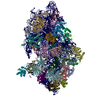
|
|---|---|
| 1 |
|
- Components
Components
-RNA chain , 3 types, 3 molecules 123
| #1: RNA chain | Mass: 24376.625 Da / Num. of mol.: 1 / Source method: isolated from a natural source Details: A at position 37 is modified (threonyl-carbamoyl-adenosine (t6A)) Source: (natural)  |
|---|---|
| #34: RNA chain | Mass: 601015.688 Da / Num. of mol.: 1 / Source method: isolated from a natural source / Details: U at position 1244 is modified / Source: (natural)  |
| #41: RNA chain | Mass: 13475.132 Da / Num. of mol.: 1 / Source method: obtained synthetically / Source: (synth.)  Homo sapiens (human) Homo sapiens (human) |
-Protein/peptide , 1 types, 1 molecules l
| #2: Protein/peptide | Mass: 3473.451 Da / Num. of mol.: 1 / Source method: isolated from a natural source / Source: (natural)  |
|---|
+40S Ribosomal protein ... , 32 types, 32 molecules CDEFGHIJKLMNOPQSTVWXYZabcdefniUR
-Protein , 3 types, 3 molecules gjk
| #31: Protein | Mass: 34669.113 Da / Num. of mol.: 1 / Source method: isolated from a natural source / Source: (natural)  |
|---|---|
| #37: Protein | Mass: 12788.764 Da / Num. of mol.: 1 / Source method: isolated from a natural source / Source: (natural)  |
| #38: Protein | Mass: 66986.812 Da / Num. of mol.: 1 / Source method: isolated from a natural source / Source: (natural)  |
-Eukaryotic translation initiation factor 2 subunit ... , 2 types, 2 molecules AB
| #35: Protein | Mass: 32792.867 Da / Num. of mol.: 1 / Source method: isolated from a natural source / Source: (natural)  |
|---|---|
| #36: Protein | Mass: 45862.441 Da / Num. of mol.: 1 / Source method: isolated from a natural source / Source: (natural)  |
-Non-polymers , 3 types, 5 molecules 

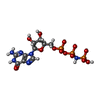


| #42: Chemical | | #43: Chemical | ChemComp-MG / | #44: Chemical | |
|---|
-Details
| Has ligand of interest | N |
|---|---|
| Has protein modification | Y |
-Experimental details
-Experiment
| Experiment | Method: ELECTRON MICROSCOPY |
|---|---|
| EM experiment | Aggregation state: PARTICLE / 3D reconstruction method: single particle reconstruction |
- Sample preparation
Sample preparation
| Component |
| ||||||||||||||||||||||||
|---|---|---|---|---|---|---|---|---|---|---|---|---|---|---|---|---|---|---|---|---|---|---|---|---|---|
| Source (natural) |
| ||||||||||||||||||||||||
| Source (recombinant) | Organism: synthetic construct (others) | ||||||||||||||||||||||||
| Buffer solution | pH: 7.4 | ||||||||||||||||||||||||
| Specimen | Embedding applied: NO / Shadowing applied: NO / Staining applied: NO / Vitrification applied: YES | ||||||||||||||||||||||||
| Vitrification | Cryogen name: ETHANE / Humidity: 100 % |
- Electron microscopy imaging
Electron microscopy imaging
| Experimental equipment |  Model: Titan Krios / Image courtesy: FEI Company |
|---|---|
| Microscopy | Model: FEI TITAN KRIOS |
| Electron gun | Electron source:  FIELD EMISSION GUN / Accelerating voltage: 300 kV / Illumination mode: FLOOD BEAM FIELD EMISSION GUN / Accelerating voltage: 300 kV / Illumination mode: FLOOD BEAM |
| Electron lens | Mode: BRIGHT FIELD |
| Image recording | Electron dose: 26 e/Å2 / Detector mode: SUPER-RESOLUTION / Film or detector model: GATAN K2 SUMMIT (4k x 4k) |
- Processing
Processing
| CTF correction | Type: NONE |
|---|---|
| 3D reconstruction | Resolution: 3 Å / Resolution method: FSC 0.143 CUT-OFF / Num. of particles: 252000 / Symmetry type: POINT |
| Atomic model building | Protocol: FLEXIBLE FIT |
 Movie
Movie Controller
Controller







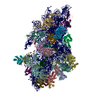
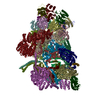



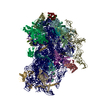

 PDBj
PDBj













































